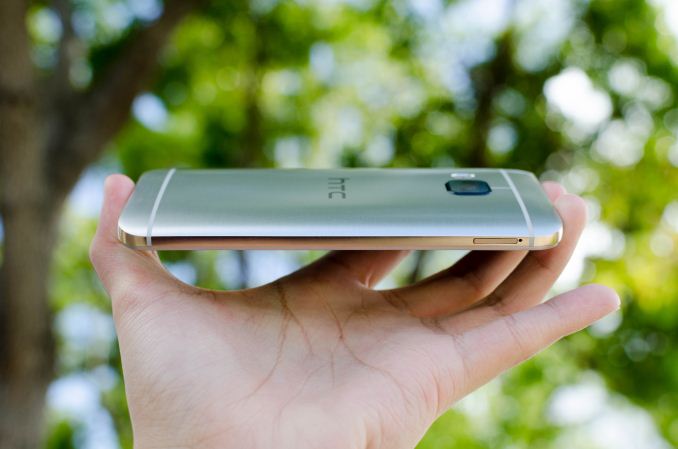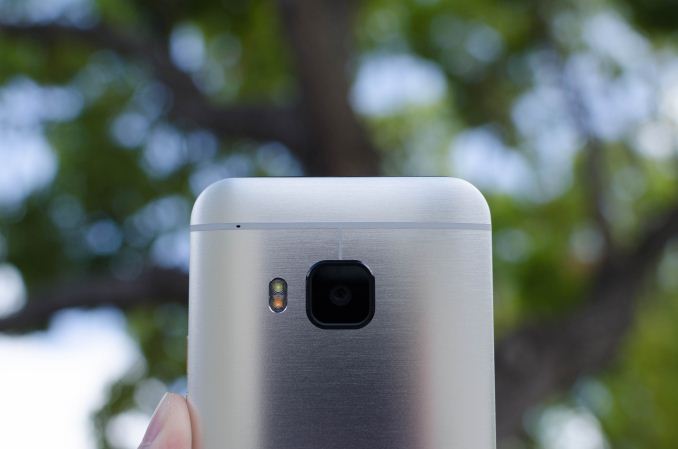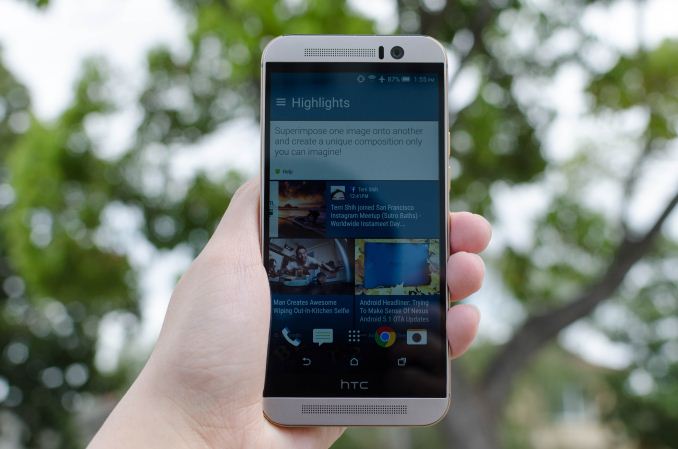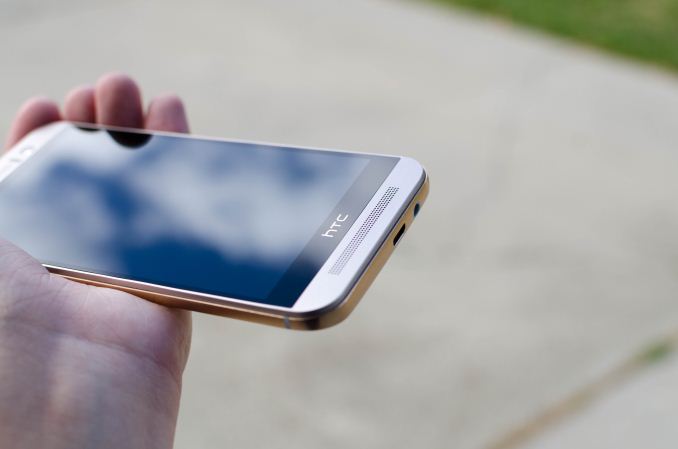The HTC One M9 Review: Part 1
by Joshua Ho on March 22, 2015 7:00 PM EST- Posted in
- Smartphones
- HTC
- Qualcomm
- Mobile
- Snapdragon 810
- One M9
Initial Conclusions
Overall, the One M9 is a pretty significant device for HTC and really sets the tone for the entire year, so it’s well worth going over everything again before we draw any conclusions about the One M9. However, any of these initial thoughts will be limited in their scope because it isn’t really possible to characterize HTC’s camera performance, nor the performance of Snapdragon 810 under load at this time due to HTC's last-minute software update. We can only really look at some key areas like the display, battery life, and SoC performance, along with design and software.
To start, HTC has done a decent job of refreshing the One design for the M9 with their new brushed finish and dual anodization process. HTC has also finally moved the power button to the right side of the phone, and improved the fit and finish of the plastic front bezel. However, there are a lot of missing details that one might have expected from a refinement of a previous design. The power button on the side ends up a bit too low for most people as far as I can tell, and ends up being rather easy to accidentally press and is also being difficult to press intentionally. The volume buttons are also easily confused for the power button, even with the textured pattern on the power button to avoid confusion. The back cover does have a nice feel, but the hard edge between the back and sides of the phone is just too sharp for everyday use and the front bezel is too far separated from the back cover to really make sense. It’s obvious that the bezel on the front of the phone can’t be eliminated, but the arrangement of the bezel combined with on screen buttons really affects the ergonomics of the device. The M7’s keyboard feels comfortably placed in comparison to the M8 and M9, which seem too tall for comfortable typing.
SoC performance is a mild improvement over Snapdragon 805, and a significant improvement in GPU over Snapdragon 801. However, it’s definitely alarming at how small the differences are when Snapdragon 810 is placed in a phone, and it seems that the thermal output of the Snapdragon 810 is high enough that sustained tests end up placing it somewhere around the range of the Snapdragon 805 in CPU-bound tests. In GPU performance, the improvements over the Snapdragon 805’s Adreno 420 are generally somewhat minimal, which really justifies HTC’s decision to go with a 1080p display for the M9.
Unfortunately, in battery life HTC manages to fall somewhat flat as the combination of the Snapdragon 810 and the loss of panel self-refresh causes a significant regression in battery life despite the increase in battery size. I’m not sure how much HTC could’ve done to prevent this, but the removal of PSR is definitely something HTC could’ve kept to try and keep battery life similar to the One M8. This is really the first generation to my memory that actually regressed on battery life in our benchmarks, which is concerning for any device with a Snapdragon 810 SoC. It may be that this is just HTC’s problem, but given that HTC has generally managed to do well at extracting maximum battery efficiency from previous platforms I’m not sure if other OEMs will be able to improve the situation here.
The display is one of the more disappointing aspects of the One M9 thus far. Although the 1080p resolution isn’t really a problem in actual use, the lack of improvement or regression in every other metric suggests that HTC has gone backwards in display quality. Combined with the removal of PSR, it’s concerning to see that cost optimization has affected such a crucial aspect of the smartphone experience. Overall, even when comparing against 2014 smartphones the One M9 ends up closer to the bottom for display quality.
The software experience seems to be one area where HTC continues to do relatively well compared to most Android OEMs, and Sense 7 remains a relatively enjoyable experience. However, the new additions to Sense 7 aren’t really all that helpful. There’s a lot of effort spent on introducing new features like additional personalization and some new widgets and applications, but none of this really feels well-differentiated, and there isn’t much change to the rest of the UI to make it mesh with Lollipop’s UI. It also seems that Snapdragon 810 causes some minor performance issues, but the effects of this are incredibly minor and it’s hard to tell whether this is due to random variance to some extent.
Although we’re still missing some of the pieces, based upon what data we have the One M9 is in an alarming place for a new smartphone. It’s pretty rare that a new phone ends up regressing in almost every major way compared to an old phone, but the One M9 ends up doing this in display and battery life. The SoC is better, but I can’t help but feel that Snapdragon 805 ends up being a better choice than Snapdragon 810 for a flagship smartphone at this time. The Snapdragon 808 may be better suited as an upgrade to the Snapdragon 805, but given the performance of the 810 I’m not really holding my breath. Given all of these issues, I’m almost tempted to point to the One M8 as the better phone, but until we get the full picture we won’t be coming to any final conclusions about the One M9.
















132 Comments
View All Comments
Gunbuster - Monday, March 23, 2015 - link
So let me get this right, It's practically indistinguishable from the old M8 design wise, has an under-clocked SOC, worse screen, no Qi, and they still haven't fixed the giant wasted HTC bezel space...flyingpants1 - Monday, March 23, 2015 - link
They just keep doing the same design over and over again... The metal is nice, but they should drop it IMHO.flyingpants1 - Monday, March 23, 2015 - link
In favor of wireless charging and larger battery. One Asian version of the HTC M7 HAD A 3200mah battery, but no LTE.pt2501 - Monday, March 23, 2015 - link
I think that with the recent change in software, Anandtech should be commended with releasing some review data on the HTC ONE M9 even in an incomplete state. This review might save someone who has been chomping at the bit from making a potential mistake.With that said and taking into account the disappointment with Snapdragon 810, I would ask and believe that it is about time we got a review of the Droid Turbo. It is one of the only phones to have the 805 refresh and i don't understand why such a major release for Motorola went without any review by Anandtech. I mean AT reviewed that POS Moto X but the real flagship phone went completely unnoticed. Aside from the GS6 and Sony Z3C there really are no other phones worth buying as of right now.
Please reconsider AT and review the Turbo. While the display is far from perfect, most other aspects are quite nice for the price.
SeannyB - Tuesday, March 24, 2015 - link
The Droid Turbo is made significantly less compelling by the fact that it's exclusive to Verizon, unlike the Moto X & Nexus 6. When was the last time AnandTech reviewed a Droid?DParadoxx - Monday, March 23, 2015 - link
Where is the Nexus 6 in these graphs?JoshHo - Monday, March 23, 2015 - link
Given that we have multiple S805 devices in the graphs we decided that it would be best to leave Nexus 6 results out. They can be seen in Bench or in previous reviews.hanseome - Monday, March 23, 2015 - link
I am sure that Samsung Galaxy S6 is the only phone announced with LPDDR4. I am really surprised to see HTC M9 with LPDD4.Madpacket - Monday, March 23, 2015 - link
Looks like the Note 4 is still the best Android phone. Disappointed by HTC here.Guest8 - Monday, March 23, 2015 - link
I can't believe my Nexus 5 still holds up LOL. I was thinking about getting the Zenfone 2 but 5.1 came out and fixed a lot of bugs and I am back to being happy again. My brother has the M7 I may just help him flash GPE to get 5.1 on his device and call it a day. I would love to see the Zenfone 2 in these benchmarks. I wonder if Anandtech will do a review?